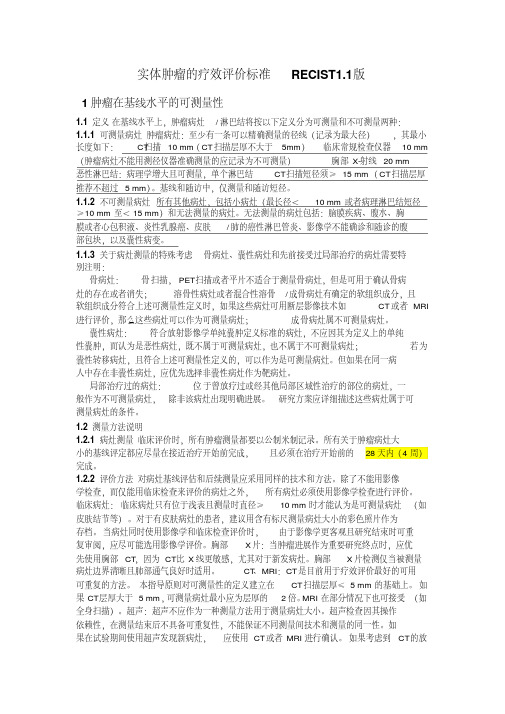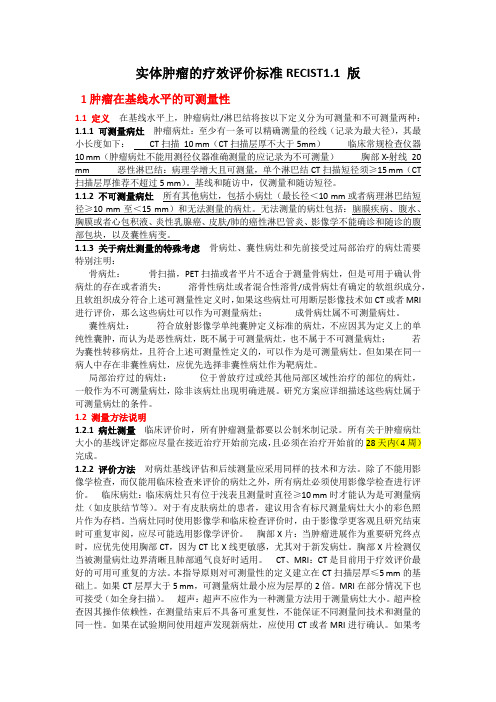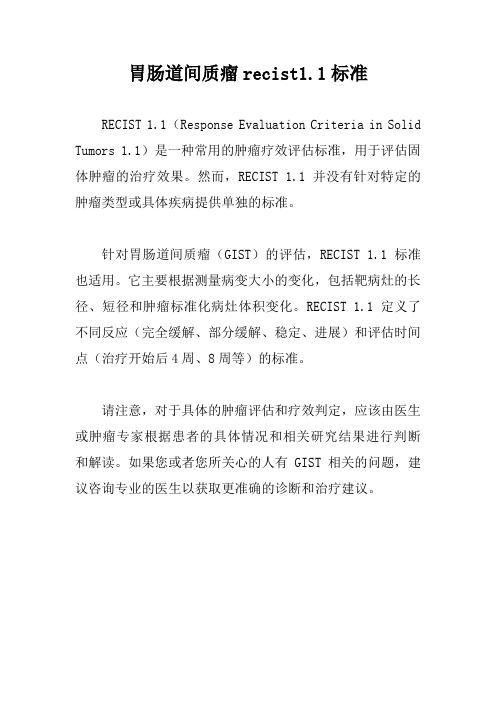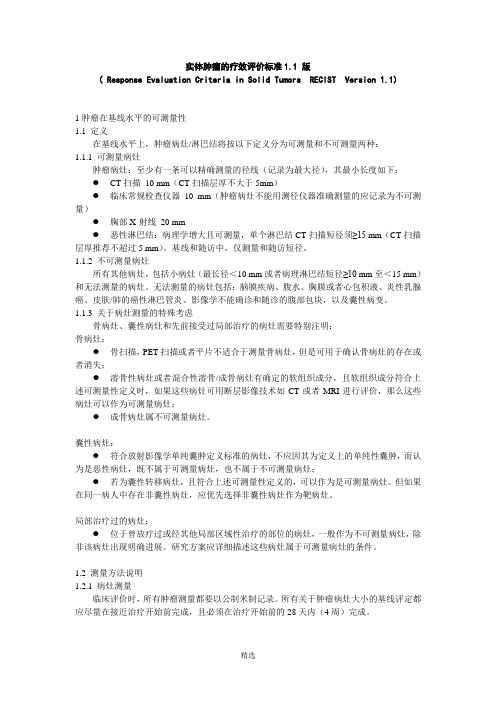recist1.1中英文校准完整版
最新Recist标准1.1.pdf

实体肿瘤的疗效评价标准RECIST1.1 版1肿瘤在基线水平的可测量性1.1 定义在基线水平上,肿瘤病灶/淋巴结将按以下定义分为可测量和不可测量两种:1.1.1 可测量病灶肿瘤病灶:至少有一条可以精确测量的径线(记录为最大径),其最小长度如下: CT扫描10 mm(CT扫描层厚不大于5mm)临床常规检查仪器10 mm (肿瘤病灶不能用测径仪器准确测量的应记录为不可测量)胸部X-射线20 mm恶性淋巴结:病理学增大且可测量,单个淋巴结CT扫描短径须≥15 mm(CT扫描层厚推荐不超过 5 mm)。
基线和随访中,仅测量和随访短径。
1.1.2 不可测量病灶所有其他病灶,包括小病灶(最长径<10 mm或者病理淋巴结短径≥10 mm至<15 mm)和无法测量的病灶。
无法测量的病灶包括:脑膜疾病、腹水、胸膜或者心包积液、炎性乳腺癌、皮肤/肺的癌性淋巴管炎、影像学不能确诊和随诊的腹部包块,以及囊性病变。
1.1.3 关于病灶测量的特殊考虑骨病灶、囊性病灶和先前接受过局部治疗的病灶需要特别注明:骨病灶:骨扫描,PET扫描或者平片不适合于测量骨病灶,但是可用于确认骨病灶的存在或者消失;溶骨性病灶或者混合性溶骨/成骨病灶有确定的软组织成分,且软组织成分符合上述可测量性定义时,如果这些病灶可用断层影像技术如CT或者MRI 进行评价,那么这些病灶可以作为可测量病灶;成骨病灶属不可测量病灶。
囊性病灶:符合放射影像学单纯囊肿定义标准的病灶,不应因其为定义上的单纯性囊肿,而认为是恶性病灶,既不属于可测量病灶,也不属于不可测量病灶;若为囊性转移病灶,且符合上述可测量性定义的,可以作为是可测量病灶。
但如果在同一病人中存在非囊性病灶,应优先选择非囊性病灶作为靶病灶。
局部治疗过的病灶:位于曾放疗过或经其他局部区域性治疗的部位的病灶,一般作为不可测量病灶,除非该病灶出现明确进展。
研究方案应详细描述这些病灶属于可测量病灶的条件。
1.2 测量方法说明1.2.1 病灶测量临床评价时,所有肿瘤测量都要以公制米制记录。
RECSIT1.1中英文对照全文

New response evaluation criteria in solid tumours: Revised RECIST guideline (version 1.1)新版实体瘤疗效评价标准:修订的RECIST指南(1.1版本)Abstract摘要Background背景介绍Assessment of the change in tumour burden is an important feature of the clinical evaluation of cancer therapeutics: both tumour shrinkage (objective response) and disease progression are useful endpoints in clinical trials. Since RECIST was published in 2000, many investigators, cooperative groups, industry and government authorities have adopted these criteria in the assessment of treatment outcomes. However, a number of questions and issues have arisen which have led to the development of a revised RECIST guideline (version 1.1). Evidence for changes, summarised in separate papers in this special issue, has come from assessment of a large data warehouse (>6500 patients), simulation studies and literature reviews.临床上评价肿瘤治疗效果最重要的一点就是对肿瘤负荷变化的评估:瘤体皱缩(目标疗效)和病情恶化在临床试验中都是有意义的判断终点。
RECIST 1.1

• 动脉期强化的病灶可选择作为mRECIST 标准的目标病灶。
肝内靶病灶选择
Unenhanced
Arterial Phase
Portal Venous Phase
The lesion is well delineated and shows a typical pattern of contrast enhancement Measure the longest diameter of the lesion in the arterial-phase scan
22
治疗前
治疗后
RECIST = SD
mRECIST = CR
23
治疗前
治疗后
RECIST = PD
mRECIST = CR
24
治疗前
治疗后
RECIST = SD
mRECIST = PR
25
治疗前
治疗后
RECIST = SD;
mRECIST = PD
26
RECIST=持续SD; 治疗前
mRECIST:CRPD 治疗后
• “存活病灶”最大直径测量方法:
– 可以和基线期靶病灶不在同一平面
– 不穿过主要坏死区域 – 在“动脉增强期”进行测量
2008年美国肝脏疾病研究协会(AASLD) 针对肝癌作出的修订-2
RECIST CR m-RECIST(HCC)
所有目标病灶消失,且肿瘤标志物正常, 所有目标病灶动脉期的增强显影均消失,
• 小于可测量标准的病灶; • 腹腔、胸腔、心包积液; • 骨病灶;
• 软脑膜转移灶;
• 炎性乳腺癌,皮肤或肺的癌性淋巴管转移;
• 影像学方法不能重复比较的,仅能通过体检发现的腹部肿
Recist标准1.1

实体肿瘤的疗效评价标准RECIST1.1 版1肿瘤在基线水平的可测量性1.1 定义在基线水平上,肿瘤病灶/淋巴结将按以下定义分为可测量和不可测量两种:1.1.1 可测量病灶肿瘤病灶:至少有一条可以精确测量的径线(记录为最大径),其最小长度如下: CT扫描10 mm(CT扫描层厚不大于5mm)临床常规检查仪器10 mm(肿瘤病灶不能用测径仪器准确测量的应记录为不可测量)胸部X-射线20 mm 恶性淋巴结:病理学增大且可测量,单个淋巴结CT扫描短径须≥15 mm(CT 扫描层厚推荐不超过5 mm)。
基线和随访中,仅测量和随访短径。
1.1.2 不可测量病灶所有其他病灶,包括小病灶(最长径<10 mm或者病理淋巴结短径≥10 mm至<15 mm)和无法测量的病灶。
无法测量的病灶包括:脑膜疾病、腹水、胸膜或者心包积液、炎性乳腺癌、皮肤/肺的癌性淋巴管炎、影像学不能确诊和随诊的腹部包块,以及囊性病变。
1.1.3 关于病灶测量的特殊考虑骨病灶、囊性病灶和先前接受过局部治疗的病灶需要特别注明:骨病灶:骨扫描,PET扫描或者平片不适合于测量骨病灶,但是可用于确认骨病灶的存在或者消失;溶骨性病灶或者混合性溶骨/成骨病灶有确定的软组织成分,且软组织成分符合上述可测量性定义时,如果这些病灶可用断层影像技术如CT或者MRI 进行评价,那么这些病灶可以作为可测量病灶;成骨病灶属不可测量病灶。
囊性病灶:符合放射影像学单纯囊肿定义标准的病灶,不应因其为定义上的单纯性囊肿,而认为是恶性病灶,既不属于可测量病灶,也不属于不可测量病灶;若为囊性转移病灶,且符合上述可测量性定义的,可以作为是可测量病灶。
但如果在同一病人中存在非囊性病灶,应优先选择非囊性病灶作为靶病灶。
局部治疗过的病灶:位于曾放疗过或经其他局部区域性治疗的部位的病灶,一般作为不可测量病灶,除非该病灶出现明确进展。
研究方案应详细描述这些病灶属于可测量病灶的条件。
1.2 测量方法说明1.2.1 病灶测量临床评价时,所有肿瘤测量都要以公制米制记录。
RECIST 1.1 中文版(精编文档).doc

【最新整理,下载后即可编辑】实体肿瘤的疗效评价标准1.1 版( Response Evaluation Criteria in Solid Tumors RECIST Version1.1)1肿瘤在基线水平的可测量性1.1 定义在基线水平上,肿瘤病灶/淋巴结将按以下定义分为可测量和不可测量两种:1.1.1 可测量病灶肿瘤病灶:至少有一条可以精确测量的径线(记录为最大径),其最小长度如下:●C T扫描10 mm(CT扫描层厚不大于5mm)●临床常规检查仪器10 mm(肿瘤病灶不能用测径仪器准确测量的应记录为不可测量)●胸部X-射线20 mm●恶性淋巴结:病理学增大且可测量,单个淋巴结CT扫描短径须≥15mm(CT扫描层厚推荐不超过5 mm)。
基线和随访中,仅测量和随访短径。
1.1.2 不可测量病灶所有其他病灶,包括小病灶(最长径<10 mm或者病理淋巴结短径≥10 mm至<15 mm)和无法测量的病灶。
无法测量的病灶包括:脑膜疾病、腹水、胸膜或者心包积液、炎性乳腺癌、皮肤/肺的癌性淋巴管炎、影像学不能确诊和随诊的腹部包块,以及囊性病变。
1.1.3 关于病灶测量的特殊考虑骨病灶、囊性病灶和先前接受过局部治疗的病灶需要特别注明:骨病灶:●骨扫描,PET扫描或者平片不适合于测量骨病灶,但是可用于确认骨病灶的存在或者消失;●溶骨性病灶或者混合性溶骨/成骨病灶有确定的软组织成分,且软组织成分符合上述可测量性定义时,如果这些病灶可用断层影像技术如CT或者MRI进行评价,那么这些病灶可以作为可测量病灶;●成骨病灶属不可测量病灶。
囊性病灶:●符合放射影像学单纯囊肿定义标准的病灶,不应因其为定义上的单纯性囊肿,而认为是恶性病灶,既不属于可测量病灶,也不属于不可测量病灶;●若为囊性转移病灶,且符合上述可测量性定义的,可以作为是可测量病灶。
但如果在同一病人中存在非囊性病灶,应优先选择非囊性病灶作为靶病灶。
局部治疗过的病灶:●位于曾放疗过或经其他局部区域性治疗的部位的病灶,一般作为不可测量病灶,除非该病灶出现明确进展。
胃肠道间质瘤recist1.1标准

胃肠道间质瘤recist1.1标准
RECIST 1.1(Response Evaluation Criteria in Solid Tumors 1.1)是一种常用的肿瘤疗效评估标准,用于评估固体肿瘤的治疗效果。
然而,RECIST 1.1 并没有针对特定的肿瘤类型或具体疾病提供单独的标准。
针对胃肠道间质瘤(GIST)的评估,RECIST 1.1 标准也适用。
它主要根据测量病变大小的变化,包括靶病灶的长径、短径和肿瘤标准化病灶体积变化。
RECIST 1.1 定义了不同反应(完全缓解、部分缓解、稳定、进展)和评估时间点(治疗开始后4周、8周等)的标准。
请注意,对于具体的肿瘤评估和疗效判定,应该由医生或肿瘤专家根据患者的具体情况和相关研究结果进行判断和解读。
如果您或者您所关心的人有GIST相关的问题,建议咨询专业的医生以获取更准确的诊断和治疗建议。
RECIST-1.1-中文版

实体肿瘤的疗效评价标准1.1 版( Response Evaluation Criteria in Solid Tumors RECIST Version 1.1)1肿瘤在基线水平的可测量性1.1 定义在基线水平上,肿瘤病灶/淋巴结将按以下定义分为可测量和不可测量两种:1.1.1 可测量病灶肿瘤病灶:至少有一条可以精确测量的径线(记录为最大径),其最小长度如下:●CT扫描10 mm(CT扫描层厚不大于5mm)●临床常规检查仪器10 mm(肿瘤病灶不能用测径仪器准确测量的应记录为不可测量)●胸部X-射线20 mm●恶性淋巴结:病理学增大且可测量,单个淋巴结CT扫描短径须≥15 mm(CT扫描层厚推荐不超过5 mm)。
基线和随访中,仅测量和随访短径。
1.1.2 不可测量病灶所有其他病灶,包括小病灶(最长径<10 mm或者病理淋巴结短径≥10 mm至<15 mm)和无法测量的病灶。
无法测量的病灶包括:脑膜疾病、腹水、胸膜或者心包积液、炎性乳腺癌、皮肤/肺的癌性淋巴管炎、影像学不能确诊和随诊的腹部包块,以及囊性病变。
1.1.3 关于病灶测量的特殊考虑骨病灶、囊性病灶和先前接受过局部治疗的病灶需要特别注明:骨病灶:●骨扫描,PET扫描或者平片不适合于测量骨病灶,但是可用于确认骨病灶的存在或者消失;●溶骨性病灶或者混合性溶骨/成骨病灶有确定的软组织成分,且软组织成分符合上述可测量性定义时,如果这些病灶可用断层影像技术如CT或者MRI进行评价,那么这些病灶可以作为可测量病灶;●成骨病灶属不可测量病灶。
囊性病灶:●符合放射影像学单纯囊肿定义标准的病灶,不应因其为定义上的单纯性囊肿,而认为是恶性病灶,既不属于可测量病灶,也不属于不可测量病灶;●若为囊性转移病灶,且符合上述可测量性定义的,可以作为是可测量病灶。
但如果在同一病人中存在非囊性病灶,应优先选择非囊性病灶作为靶病灶。
局部治疗过的病灶:●位于曾放疗过或经其他局部区域性治疗的部位的病灶,一般作为不可测量病灶,除非该病灶出现明确进展。
实体瘤疗效评价标准(RECIST1 1)

CT 或 MRI : CT 是目前用于疗效评价最好的方法。胸腹盆腔用
10mm,螺旋CT用5mm层面连续扫描。
超声:一般不作为评价手段。但是如果有可以触及的病变,或
者表浅病变完全消失,超声检查可作为触诊(有标尺的彩照)的补充。
内窥镜和腹腔镜:仅用于证实病理CR。
新病灶
在随访中已检测到的而在基线检查中未发现的病灶将视 为新的病灶,提示疾病进展 如果一个新的病灶是不明确的,比如因其形态小所致, 则需要进一步的治疗和随访评价以确认其是否是一个新 的病灶。 如果重复的检查证实其是一个新的病灶,那么疾病进展 的时间应从其最初的发现的时间算起。 PET-CT评估疗效虽需进一步研究明确,但某些情况下仍 可成为CT的有效补充来判断疾病的进展(尤其在新病灶 方面)
Reporting Results of Cancer Treatment
AB Miller, B Hogestraeten, M Staquet, A Winkler
Cancer 47:207–14,
RECIST 1.1 Eisenhauera, et al, EJC, 2009
判断疗效的 标准
分离或结合的病灶: 当非结节性病灶分裂成碎片状时,将各分离部分的最长径加 起来计算病灶的直径之和。 同样,对于结合型病灶,通过各结合部分间的平面可将其区 分开来,然后计算各自的最大直径。但如果结合得密不可分, 最长径应取融合病灶整体的最长径。
肿瘤疗效评价-非靶病灶
非靶病灶 评价标准
所有非靶病灶消失,且肿瘤标记物恢复至正 常水平。所有淋巴结无病理性意义(短径< 10 mm) 存在一个或多个非靶病灶和/或持续存在肿瘤 标记物水平超出正常水平。 已存在的非靶病灶出现明确进展。 注:出现一个或多个新病灶也被视为疾病进 展。
- 1、下载文档前请自行甄别文档内容的完整性,平台不提供额外的编辑、内容补充、找答案等附加服务。
- 2、"仅部分预览"的文档,不可在线预览部分如存在完整性等问题,可反馈申请退款(可完整预览的文档不适用该条件!)。
- 3、如文档侵犯您的权益,请联系客服反馈,我们会尽快为您处理(人工客服工作时间:9:00-18:30)。
1.Background1背景1.1.History of RECIST criteria1.1RECIST标准的历史Assessment of the change in tumour burden is an important feature of the clinical evaluation of cancer therapeutics.Both tumour shrinkage(objective response)and time to the development of disease progression are important endpoints in cancer clinical trials.The use of tumour regression as the endpoint for phase II trials screening new agents for evidence of anti-tumour effect is supported by years of evidence suggesting that,for many solid tumours,agents which produce tumour shrinkage in a proportion of patients have a reasonable(albeit imperfect)chance of subsequently demonstrating an improvement in overall survival or other time to event measures in randomised phase III studies (reviewed in[1],[2],[3]and[4]).At the current time objective response carries with it a body of evidence greater than for any other biomarker supporting its utility as a measure of promising treatment effect in phase II screening trials.Furthermore,at both the phase II and phase III stage of drug development, clinical trials in advanced disease settings are increasingly utilising time to progression(or progression-free survival)as an endpoint upon which efficacy conclusions are drawn,which is also based on anatomical measurement of tumour size.评价肿瘤负荷的改变是癌症治疗的临床评价的一个重要特征。
肿瘤缩小(客观缓解)和疾病进展时间都是癌症临床试验中的重要终点。
为了筛查新的抗肿瘤药物,肿瘤缩小作为II期试验重点被多年研究的证据所支持。
这些研究提示对于多种实体肿瘤来说,促使部分病人肿瘤缩小的药物以后都有可能(尽管不完美)被证实可提高在随机Ⅲ期试验中病人的总体生存期或进入其他事件评价的可能。
目前在Ⅱ期筛查试验中评价治疗效果的指标中,客观缓解比任何其他生物标记更可靠。
而且,在Ⅱ和Ⅲ期药物试验中,进展期疾病中的临床试验正越来越利用疾病进展的时间(无进展生存)作为得出有治疗效果结论的终点,而这些也是建立在肿瘤大小的解剖学测量基础上。
However,both of these tumour endpoints,objective response and time to disease progression,are useful only if based on widely accepted and readily applied standard criteria based on anatomical tumour burden.In1981the World Health Organisation(WHO)first published tumour response criteria,mainly for use in trials where tumour response was the primary endpoint.The WHO criteria introduced the concept of an overall assessment of tumour burden by summing the products of bidimensional lesion measurements and determined response to therapy by evaluation of change from baseline while on treatment.5However,in the decades that followed their publication,cooperative groups and pharmaceutical companies that used the WHO criteria often‘modified‘them to accommodate new technologies or to address areas that were unclear in the original document.This led to confusion in interpretation of trial results6and in fact,the application of varying response criteria was shown to lead to very different conclusions about the efficacy of the same regimen.7In response to these problems,an International Working Party was formed in the mid1990s to standardise and simplify response criteria. New criteria,known as RECIST(Response Evaluation Criteria in Solid Tumours),were published in 2000.8Key features of the original RECIST include definitions of minimum size of measurable lesions, instructions on how many lesions to follow(up to10;a maximum five per organ site),and the use of unidimensional,rather than bidimensional,measures for overall evaluation of tumour burden.These criteria have subsequently been widely adopted by academic institutions,cooperative groups,andindustry for trials where the primary endpoints are objective response or progression.In addition, regulatory authorities accept RECIST as an appropriate guideline for these assessments.然而这些肿瘤终点、客观缓解和疾病进展时间,只有建立在以肿瘤负荷解剖学基础上的广泛接受和容易使用的标准准则上才有价值。
1981年世界卫生组织(WHO)首次出版了肿瘤评价标准,主要用于肿瘤缓解是主要终点的试验中。
WHO标准通过测量病变二维大小并进行合计介绍了肿瘤负荷总体评价的概念,通过评价治疗期间基线的改变而判断治疗的反应。
然而,在该标准出版后的十几年中,使用该标准的协作组和制药公司通常对其进行修改以适应新的技术或在原始文献中提出了不清楚的地方,这就导致了试验结果解释的混乱。
事实上,各种评价标准的应用导致同一种治疗方法的治疗效果大相径庭。
对这些问题的反应是国际工作组于19世纪中期形成,并对评价标准进行了标准化和简化。
新的标准,也称为RECIST(实体肿瘤的反应评价标准)于2000年出版。
最初的RECIST关键特征包括病变最小大小的确定、对随访病变数目的建议(最多10个;每个器官最多5个)、一维而不是二维的使用、肿瘤负荷的总体评价。
这些标准后来被学术团体、协作组和制药工业广泛采用,而该标准的主要终点就是客观缓解或疾病进展。
另外,当局接受RECIST作为这些评价的合适的标准。
1.2.Why update RECIST?Since RECIST was published in2000,many investigators have confirmed in prospective analyses the validity of substituting unidimensional for bidimensional(and even three-dimensional)-based criteria (reviewed in[9]).With rare exceptions(e.g.mesothelioma),the use of unidimensional criteria seems to perform well in solid tumour phase II studies.1.2为什么要更新RECIST?自从2000年出版RECIST后,许多研究者在前瞻性研究中证实了将二维测量为基础的标准(甚至是三维测量)替换为一维测量的有效性。
除了少数例外(如间皮瘤),一维测量标准似乎在实体肿瘤Ⅱ期试验中更好。
